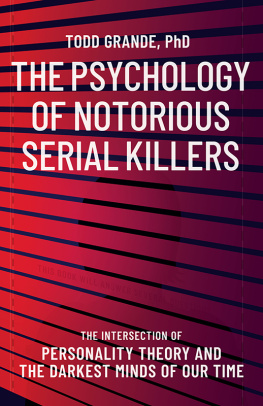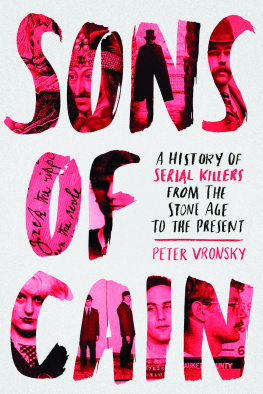Table of Contents
THE PSYCHOLOGY
OF NOTORIOUS
SERIAL KILLERS
THE INTERSECTION OF
PERSONALITY THEORY AND
THE DARKEST MINDS OF OUR TIME
Publishers Note
This publication is designed to provide accurate and authoritative information about the subject matters covered. It is sold with the understanding that neither the author nor publisher are rendering mental health, medical, legal or other professional services or advice, either directly or indirectly. If expert assistance, therapeutic, or legal services is needed, the services of a competent professional should be sought. Neither the author nor the publisher shall be liable or responsible for any loss or damage allegedly arising as a consequence of your use or application of any information or suggestions in this book.
Copyright 2021 by Todd Grande
Unhooked Books, an imprint of High Conflict Institute Press
7701 E. Indian School Rd., Ste. F
Scottsdale, AZ 85251
www.unhookedbooks.com
ISBN (print): 978-1950057252
ISBN (ebook): 978-1950057269
Cover design by Julian Len, The Missive
Interior Design by Jeffrey Fuller, Shelfish
Library of Congress Number: 2020946599
All rights reserved.
Printed in United States of America
No part of this book may be reproduced, scanned, or distributed in any printed, electronic, or audible form or any form in the future that is not yet known, without the express written permission of the publisher.
Failure to comply with these terms may expose you to legal action and damages for copyright infringement.
For all mental health professionals
who dont shy away from
the tough cases.
Contents
Introduction
Years before I was a licensed mental health counselor, I developed an interest in unusual human behavior. I wanted to know why people chose to act in certain ways, what motivated them to maintain behavior, and what could lead them onto the road to recovery from destructive patterns. One of the most fascinating behaviors is serial homicide. Like so many, I read a number of articles and books on myriad notorious serial killers. Their behavior was inexplicable, disorganized, and malicious. What could possibly motivate somebody to conduct serial homicides?
As I moved forward in my education, I continued to study this aberrant behavior. Even though the topic was fascinating I could not commit a tremendous amount of time to write about serial killers because I was working on my Ph.D. in counselor education and supervision, actively treating clients as a counselor, supervising counselors, and conducting various consultations.
When I would have a moment to read about psychopathy, narcissism, sadism, and other traits related to serial homicide, I would record various insights that had occurred to me. Over the course of several years, I became better at memorializing these notes digitally and storing them someplace where I could retrieve them at a later date. This system was enhanced when I started creating YouTube videos about serial killers. For every video I produced, regardless of the topic, I would create an outline with a mixture of various talking points and verbatim scripts. As I continued to grow my YouTube channel my outlines were populated with almost entirely verbatim text.
Shortly after I started doing this, I realized that each of my outlines was essentially a book chapter. I had always wanted to write books on serial killers as well as several other topics related to mental health and personality, so I decided to construct this book using selected outlines combined with other insights I have had about these killers throughout the years.
Over the course of several months, I built a hierarchy of the various ideas related to the mental health, personality, motivation, and types of serial killers. From this book schematic, I was able to arrange all of the chapters, format them for use in a book, and add my other ideas to complete this text.
My own personality both facilitated and slowed the completion of this book. On the plus side, I tend to be high in openness to experience, conscientious, and low in extraversion, which helped me to be creative, diligent, and apply good analytical skills. The same high conscientiousness that made the process move quickly also applied the brakes as I wanted to make sure that my analyses demonstrated a consistent application of scientific principles.
The fields of mental health counseling and other related fields like psychology and social work are not always known for their scientific rigor. A popular conceptualization is these are soft sciences, which contain research that technically follows the scientific method, but still does not elucidate the topics with the type of clarity we see in other fields like chemistry or physics. This type of thinking allows myriad speculation and unsupported conceptualizations to creep into many narratives about topics like serial killers. To the extent possible, I tried to reduce the inclusion of material that may drift quite a distance away from empirically supported principles. In this framework, I tried to offer insights that are new, informed by science, and logical.
Learning about serial killers can lead to the development of skills in a number of areas including but not limited to personality theory, abnormal behavior, emotional regulation, and cognition. Through the study of these killers extreme behavior, all behavior becomes a little bit more understandable. All human behavior is on a continuum, therefore, even though there are relatively few serial killers, there are many people who have various characteristics of serial homicide offenders like the tendency to manipulate, a sense of entitlement, grandiosity, impulsivity, and a lack of empathy.
I hope that through reading this book, you learn not only about serial killers but more about the human condition in general.
SECTION 1
CHAPTER 1
The Minds of Killers
This book explores personality theory as it applies to most notorious serial killers in recent history. The science of personality theory has advanced dramatically in recent years and has cleared the way for this useful and edifying speculation about the inner workings of horrific serial killers. This book will answer several questions:
What drives a serial killer?
How does sexual desire fit into the motivation of a serial killer?
Why do some serial killers stop killing while others escalate?
What are the different types of serial killers based on personality theory?
These questions will be answered through an exploration of over a dozen modern serial killers.
Although serial killers have existed just about as long as human society itself, interest in this particular type of homicide offender has increased markedly since the 1970s. The rise in interest started with a few serial killers who were active in that decade namely, Ted Bundy, Ed Kemper (Co-ed Killer), David Berkowitz (Son of Sam), and Kenneth Bianchi (Hillside Strangler).
As time moved on, serial killers continued to emerge and fascinated people in the same way as the killers from the 1970s and in new ways. Richard Ramirez (Night Stalker) shocked people with his extreme and erratic violence as he terrorized California during a spree of killing and rape. Citizens in the area bought guns, alarm systems, and dogs, worried that they would be the next victims of this ruthless and unpredictable killer.








![Charlotte Greig - Evil Serial Killers. In the Minds of Monsters [Fully Illustrated]](/uploads/posts/book/70143/thumbs/charlotte-greig-evil-serial-killers-in-the-minds.jpg)



